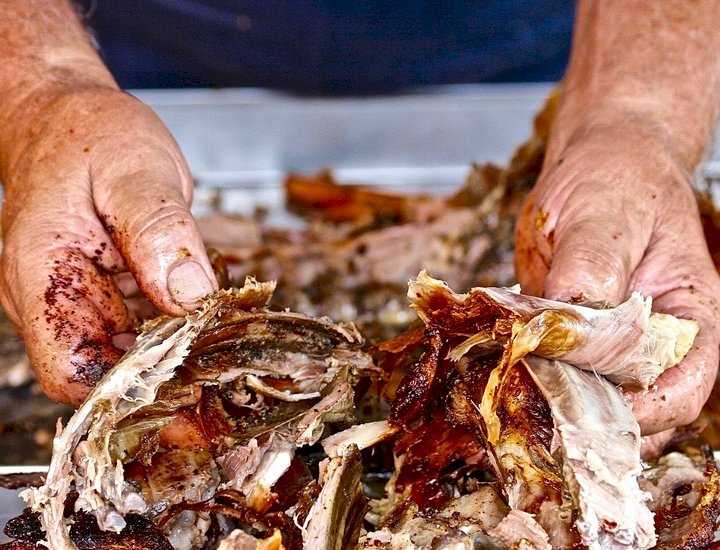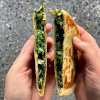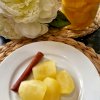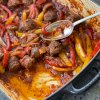Nikiforo’s Lamb on the Spit
Nikiforo's Lamb on the spit promises to be the most succulent and packed with flavour Greek style lamb that you have ever tasted.
Ingredients
1 whole lamb with head intact and abdomen partially split, fresh or defrosted and dressed in veil or caul fat (best to advise your butcher that the lamb is for roasting on a spit
4 tablespoons salt
2 tablespoons pepper
1/2 tablespoon oregano
1/2 tablespoon chillies dried
Preparation
Watch the full video below. Thank you for subscribing to my YouTube channel!
Select the BBQ and burning materials
You will need a BBQ that has an automatic rotisserie function and is capable of maintaining a consistent fire. You will also need briquettes or wood for the fire – 20kg of briquettes or 50kg of wood is recommended to ensure you don’t run out. Hardwood such as red gum or oak is recommended because it produces good charcoals that remain aglow longer.
Light the fire
Light the fire at least one hour before you start roasting the lamb to ensure the fire reaches charcoal stage.
Select some dry wood and split it into thin pieces. Use a piece of paper to start the fire.
Affix the lamb to the spit
Cross and tie the lamb’s legs together using wire
There are many different types of hardware that can be used to affix the lamb to the spit that are all variations on the same theme.
We are describing how Nikiforo affixes his lamb to the spit – as seen in the accompanying KO video.
Take a set of U-shaped prongs that have an ‘O’ ring at their base and push the prongs through the lamb’s back, going from inside the lamb’s abdominal cavity to the outside.
Slide another set of U-shaped prongs onto the spit, so that the prongs face towards the rear of the lamb. Pass the spit through the lamb’s rear; the ‘O’ ring on the U-shaped hardware in the abdominal cavity; its neck; and its mouth.
Push the prongs of the second U-shaped hardware firmly into the thighs of the lamb.
Place a flat metal plate (with two corresponding holes) over the two protruding prongs on the lamb’s back, thread bolts and a nut onto each prong. Tighten the nuts.
Firmly tighten the nuts on all the fastenings.
Use stainless steel wire to securely affix the lamb’s legs and neck to the spit.
Note: Regardless of which types of hardware you use, you must ensure the lamb is firmly affixed to the spit and as level as possible, so that it cooks evenly.
Season the lamb
Prepare the seasoning by combining the salt, pepper, oregano and dried chillies in a bowl.
Generously sprinkle the seasoning in the abdominal cavity; the inner neck area; and in small incisions in the lamb’s inner thighs.
Using either wire, twine or home-made bamboo sticks (3 needed), stitch up the lamb’s abdomen, by passing the wire, twine or honed end of the bamboo stick from the outside of the abdominal skin to the inside on one side of the lamb and then from the outside of the abdominal skin to the inside on the other side of the lamb, and back out on the first side.
Roast the lamb
Once the fire reaches charcoal stage, you can start roasting the lamb.
Throughout the cooking process, you need to maintain a continuous and consistent fire by adding wood to the fire near the head and rear of the lamb, rather than the abdominal area. You also need to continuously rotate the lamb.
For the first hour of cooking, place the lamb approximately 40 – 50cm away from the fire. This will allow the lamb’s abdominal cavity to heat up slowly from the inside without browning the outside of the lamb too quickly. In this way, the fat in the lamb will begin to melt and drip out of the lamb. Once these fatty juices begin dripping out of the lamb, move the lamb closer – approximately 20cm from the fire.
Cooking time varies depending on the size of the lamb, but it typically takes around 3 to 4 hours. You can tell the lamb is ready when it’s no longer releasing juices. You can also check by stabbing the lamb’s thigh and if juices are not released, again it’s ready.
Serve the lamb
Once the lamb is cooked, remove it from the fire and place it on a large tray on a flat surface. Remove the hardware and spit. Carve the lamb into serving sizes, season with more salt and pepper if you desire and arrange on a serving tray.
Lamb is best-served warm, straight off the fire. For a traditional Greek celebration, serve it with KO’s tzatziki, baked potatoes and KO’s Greek salad.
Leftovers can be refrigerated for up to a week and are best served cold and seasoned with more salt and pepper.




